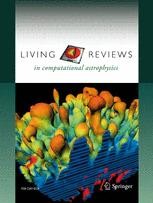LRCA: Modelling of stellar convection
 Kupka, F & Muthsam, HJ, Modelling of stellar convection, Living Rev Comput Astrophys (2017) 3:1. https://doi.org/10.1007/s41115-017-0001-9
Kupka, F & Muthsam, HJ, Modelling of stellar convection, Living Rev Comput Astrophys (2017) 3:1. https://doi.org/10.1007/s41115-017-0001-9
Review Article | Open Access
Published: 18 July 2017
Abstract:
The review considers the modelling process for stellar convection rather than specific astrophysical results. For achieving reasonable depth and length we deal with hydrodynamics only, omitting MHD. A historically oriented introduction offers first glimpses on the physics of stellar convection. Examination of its basic properties shows that two very different kinds of modelling keep being needed: low dimensional models (mixing length, Reynolds stress, etc.) and “full” 3D simulations. A list of affordable and not affordable tasks for the latter is given. Various low dimensional modelling approaches are put in a hierarchy and basic principles which they should respect are formulated. In 3D simulations of low Mach number convection the inclusion of then unimportant sound waves with their rapid time variation is numerically impossible. We describe a number of approaches where the Navier–Stokes equations are modified for their elimination (anelastic approximation, etc.). We then turn to working with the full Navier–Stokes equations and deal with numerical principles for faithful and efficient numerics. Spatial differentiation as well as time marching aspects are considered. A list of codes allows assessing the state of the art. An important recent development is the treatment of even the low Mach number problem without prior modification of the basic equation (obviating side effects) by specifically designed numerical methods. Finally, we review a number of important trends such as how to further develop low-dimensional models, how to use 3D models for that purpose, what effect recent hardware developments may have on 3D modelling, and others.
